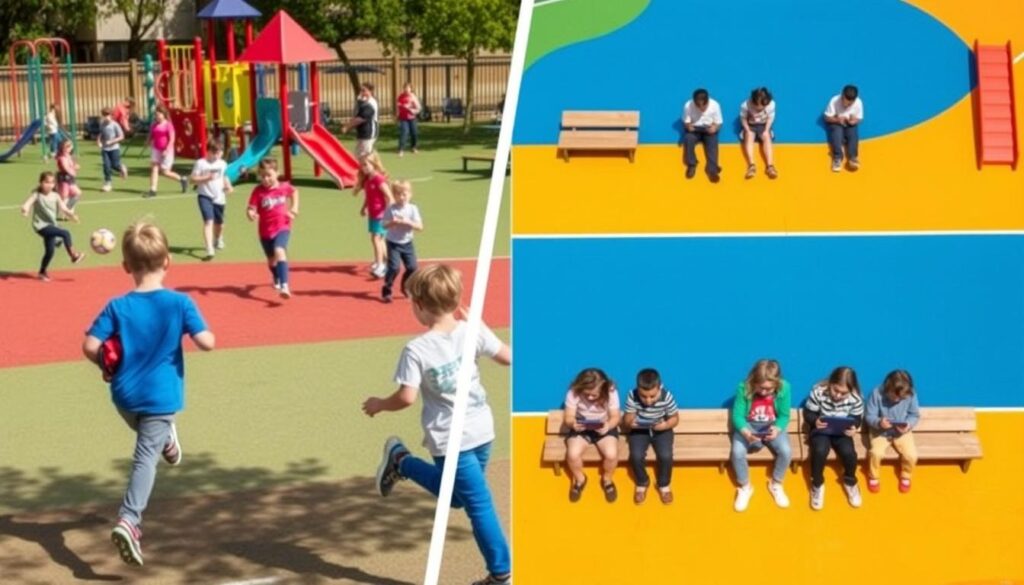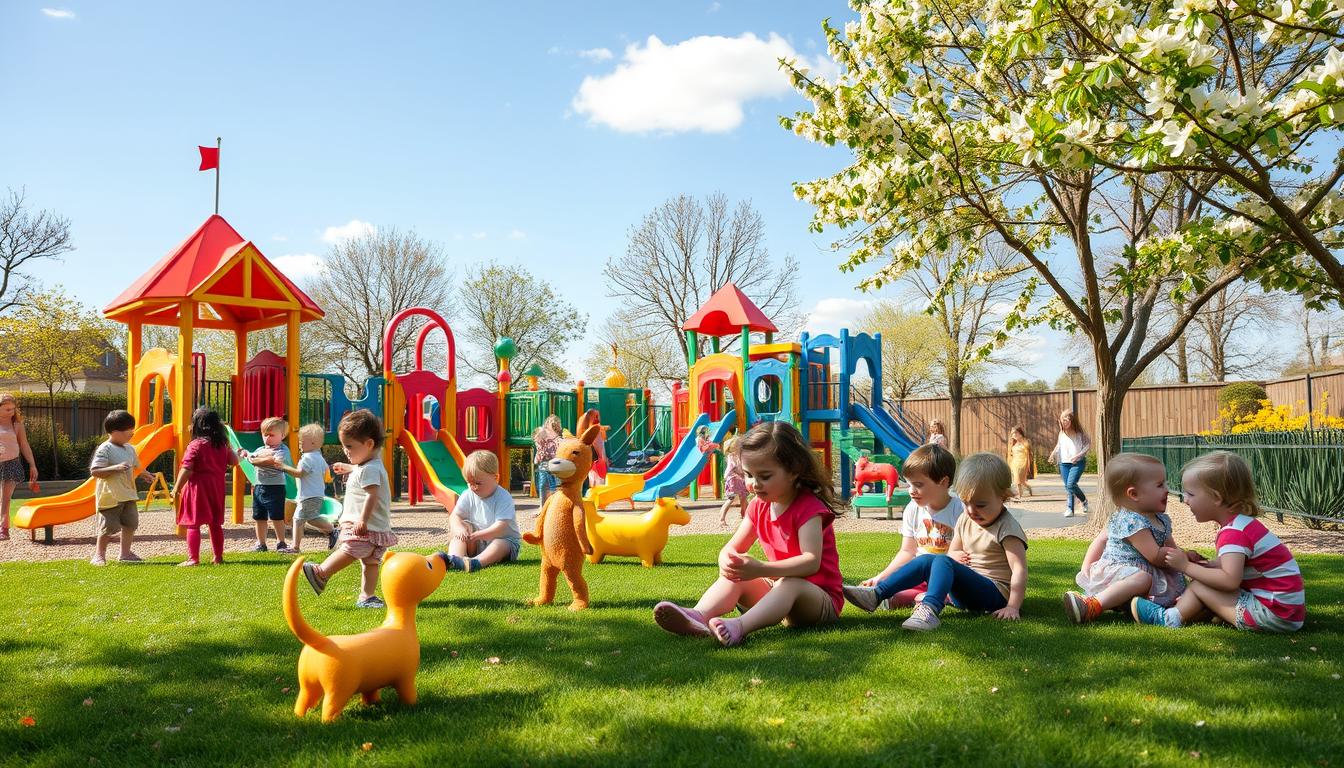In Australia, more and more kids are leading sedentary lives. This has made physical inactivity a big concern for public health. This article explores why this is happening, the health risks it poses, and how we can get kids moving again.

How to help Kids and Physical Inactivity: Causes and Solutions
Key Takeaways
- Alarming rates of sedentary behaviour and lack of physical activity among Australian children
- Serious health risks associated with childhood obesity and physical inactivity
- Importance of outdoor play, exercise, and limiting screen time for kids
- Role of schools, communities, and families in promoting active lifestyles for children
- Strategies to overcome barriers and encourage a more physically active childhood
How to help Kids and Physical Inactivity: Causes and Solutions
In Australia, many kids are spending too much time sitting. This is a big worry for their health. It’s important to get them moving more.
The Prevalence of Sedentary Lifestyles
Research shows that lots of Australian kids don’t get enough exercise. They spend too much time on screens and not enough playing outside. School and other activities also take up a lot of their time.
Impacts on Children’s Health and Well-being
Being inactive can harm kids in many ways. It can lead to obesity, heart problems, and affect their brains. It also makes them more likely to feel sad, anxious, and lonely.
We need to understand the risks of not moving enough. Then, we can work on making kids healthier and more active. This is crucial for Australian youth.
Causes of Physical Inactivity in Children
In Australia, more kids are not getting enough exercise. This is because they spend a lot of time on digital devices. They miss out on playing outside and being active.
Another reason is the pressure to do well in school and other activities. Kids have a lot to do, leaving little time for sports or games. This can harm their health and happiness.
Family habits also play a big role. If families don’t value exercise, kids are less likely to either. Changing this can be hard for parents and caregivers.
| Factors | Impact on Physical Activity |
|---|---|
| Increased screen time | Decreased time for outdoor play and physical exercise |
| Academic and extracurricular pressures | Less time and energy for physical activities |
| Sedentary family habits | Adoption of similar inactive lifestyles by children |
To tackle this issue, we need to work together. We should aim for a lifestyle that balances school, activities, and being active. This way, we can help kids stay healthy and happy.
Lack of Physical Activity for Kids
In recent years, Australian children’s lack of physical activity has become a big worry. Technology and digital fun have grown, making kids sit still more often. This has led to a worrying trend of kids not moving enough.
Factors Contributing to Sedentary Behaviour
Many things contribute to kids sitting too much. Kids are glued to screens, phones, and TVs, lessening outdoor and exercise time. Schools also cut back on physical education, making things worse.
Money and environment also matter. Kids from lower-income households get fewer chances to play sports. And, not having safe outdoor spaces in some areas makes kids less likely to play outside. These issues, along with the ease of sitting still, have led to more kids not exercising enough.
| Factor | Impact |
|---|---|
| Increased screen time | Reduced outdoor play and physical exercise |
| Limited physical education in schools | Decreased opportunities for kids to be active |
| Socioeconomic disparities | Unequal access to organized sports and recreational activities |
| Lack of safe outdoor spaces | Discouraging physical activity in the community |
Knowing these factors helps us find better ways to get kids moving. We can work on making sure kids in Australia are active and healthy.
Childhood Obesity and Its Consequences
Childhood obesity is a big worry in Australia. The number of overweight and obese kids has gone up a lot in the last ten years. It’s very important to tackle the link between not moving enough and getting overweight.
Health Risks Associated with Inactivity
Children who don’t move much face serious health problems. They are more likely to get cardiovascular disease, type 2 diabetes, and even mental health issues like depression and anxiety.
- Cardiovascular disease: Not moving enough can lead to blocked arteries. This can cause high blood pressure and increase the risk of heart attacks and strokes.
- Type 2 diabetes: Being overweight as a kid is a big risk for getting type 2 diabetes. This is a serious condition that can harm your health for a long time.
- Mental health: Sitting too much is linked to more depression and anxiety in kids. This shows how important it is for kids to be active.
These health risks show we need to act fast to help kids be more active. By supporting active lifestyles, we can fight childhood obesity and its serious effects.
“Childhood obesity is not just a cosmetic problem, it is a health problem that can lead to serious long-term consequences. We must act now to encourage and support our children in adopting healthy, active lifestyles.”
The Importance of Outdoor Play and Exercise
In today’s digital world, outdoor play and exercise are key for Australian kids. Studies show how important active play is for their minds and bodies.
Outdoor play boosts physical health and helps with thinking and social skills. Kids who run, climb, and explore get stronger and smarter. They also learn to solve problems, be creative, and talk better with others.
“Outdoor play is essential for the healthy development of Australian children. It allows them to connect with nature, challenge themselves physically, and learn valuable life skills.”
But, too many kids today don’t get enough outdoor play. This lack of activity can lead to serious health problems. These include obesity, heart disease, and mental health issues.
By focusing on outdoor play and exercise, we help our kids live healthier lives. Parents, schools, and communities need to work together. They should make sure every child gets to enjoy the benefits of being active.
There are many ways to get kids moving, like playing in parks or joining sports. By encouraging a love for the outdoors and movement, we prepare them for a happy, healthy future.
Screen Time and Its Effects on Children’s Activity Levels
Australian kids are spending more time on screens, which is worrying. Smartphones, tablets, and games are making them less active. This has led to a rise in physical inactivity in youth and a sedentary lifestyle in children.
Balancing Technology and Physical Activity
Digital devices can be educational and fun. But too much screen time means less time for playing outside, sports, and exercise. Kids and screen time are now closely linked, with many kids spending hours on screens each day.
- Research links too much screen time to lower fitness, weaker muscles, and a higher obesity risk in kids.
- Digital entertainment’s sedentary nature can lower physical activity in Australian youth, leading to health issues.
Parents and caregivers need to help kids balance tech use and physical activity. Setting limits on screen time and encouraging outdoor play, sports, and other activities is key. This way, families can ensure kids stay active and healthy.
“The key is to find a healthy balance between technology and physical activity, so that our kids can reap the benefits of both without compromising their overall health and well-being.”
TO WATCH VIDEO CLICK HERE
Australian families can manage kids and screen time well. With the right approach, technology can support a healthy, active childhood.
Strategies for Promoting Physical Activity in Schools
Schools are key in the battle against physical inactivity among Australian youth. By improving physical education (PE) programs, teachers can encourage active lifestyles. They also teach the value of exercise early on.
Enhancing Physical Education Programs
To boost physical activity in schools, a variety of strategies are needed. This includes:
- Offering a wide range of fun activities, from sports to new fitness programs. This caters to different interests and abilities of students.
- Increasing the number and length of PE classes. This ensures kids get enough chances to be active during the school day.
- Working with local communities. Schools can use the help of sports clubs, recreational centres, and healthcare providers. This improves the quality and reach of PE programs.
By focusing on physical activity, schools can make a big difference. They can help tackle physical inactivity among Australian youth. This approach not only boosts physical health but also supports overall well-being. It helps kids appreciate being active for life.
“Incorporating physical activity into the school day is essential for the health and well-being of our students. It’s not just about fitness – it’s about building confidence, fostering teamwork, and cultivating a love for an active lifestyle.”
– Jane Doe, Principal of ABC Primary School
Encouraging Family-Based Physical Activities
Getting families to be active is key to helping Aussie kids move more. Parents and caregivers are very important in shaping kids’ habits. By being active themselves, they can encourage kids to be more active too.
Planning fun outdoor activities is a great way to get everyone moving. You could go on weekend hikes, cycle together, or play games like tag in the park. Making exercise fun and a family activity helps kids learn the value of being active.
Adding physical activities to daily life is another good strategy. You can encourage kids to walk or cycle to school instead of driving. Or, have a family dance session or set up an indoor obstacle course each evening. These small changes can make a big difference in keeping kids active.
| Activity | Benefits | Time Commitment |
|---|---|---|
| Family hikes | Improved cardiovascular health, strengthened muscles, and enhanced mental well-being | 1-2 hours per weekend |
| Backyard games | Increased physical activity, reduced screen time, and opportunities for bonding | 30-60 minutes per day |
| Cycling to school | Reduced carbon footprint, improved physical fitness, and more time spent outdoors | 15-30 minutes per day |
Creating an active home environment is vital. Families can help tackle the issue of kids not being active enough. This promotes healthier and more balanced lifestyles for everyone.
“The family that plays together, stays together.”
Community Involvement and Safe Outdoor Spaces
Creating outdoor spaces that are fun and safe is key to getting kids moving in Australia. Working with local communities helps make sure these spaces meet the needs of young people. This encourages them to be active.
Creating Accessible Recreational Facilities
Local governments and community groups are crucial in making outdoor spaces safe and welcoming. Some important steps include:
- Investing in well-maintained parks, playgrounds, and sports courts that are easily accessible to children and families.
- Collaborating with schools to open up school grounds for public use after hours, expanding the availability of play areas.
- Designing inclusive spaces that accommodate children with diverse abilities, ensuring equal opportunities for physical activity.
- Incorporating features like walking trails, bike paths, and open green spaces that promote active transportation and outdoor exploration.
These efforts not only tackle physical inactivity in youth but also build a sense of belonging and social connection. These are key for kids’ overall well-being.
| Benefit | Impact |
|---|---|
| Increased physical activity | Reduced risk of childhood obesity and associated health issues |
| Improved mental health | Lower incidence of children’s health risks like anxiety and depression |
| Enhanced social interaction | Stronger sense of community and decreased lack of outdoor play |
By focusing on creating safe and engaging outdoor spaces, communities can greatly help in raising active and healthy lifestyles for Australian children.
“Investing in safe, inclusive, and accessible outdoor spaces is an investment in the health and well-being of our community’s children.”
Overcoming Barriers to Active Lifestyles for Kids
Getting kids to be active can be tough. In Australia, things like culture, money, and too much schoolwork can stop them from moving. These issues lead to kids not being as active as they should be.
Many think schoolwork is more important than being active. This view stops kids from playing sports or moving around. We need to change this by showing how being active helps kids in many ways.
- Money problems can make it hard for kids to play sports or go to the gym.
- Too much homework, TV, and other activities can leave kids with no time to play.
We need a plan to help kids be more active. Parents, teachers, and community leaders must work together. Here’s how:
- We should ask for more money for sports in schools.
- We need safe places for kids to play outside.
- We should teach families about the right balance between tech and being active.
By tackling these problems, we can help Australian kids be more active. This will improve their health, minds, and social skills.
The Role of Parents and Caregivers
Parents and caregivers are the main role models for kids in Australia. They play a big part in encouraging active lifestyles and healthy habits. By being active themselves, they can inspire kids to be more active too.
Modelling Healthy Habits
Children often copy what their parents and caregivers do. If parents are active, like going for walks or playing sports, kids are more likely to follow. Parents can also encourage outdoor play and limit screen time.
This helps kids develop a love for movement. A study showed that kids of active parents are up to 2.5 times more likely to be active themselves. This shows how important parents are in helping kids stay active.
| Parental Influence on Children’s Physical Activity | Percentage |
|---|---|
| Children of active parents more likely to be physically active | 2.5 times |
| Reduction in sedentary lifestyle in children with active parents | 40% |
| Decrease in children’s health risks with active parental role models | 30% |
By being active and promoting physical activity, parents and caregivers can greatly impact kids’ health. They help reduce physical inactivity in youth and lower health risks for children.
TO SEE MORE TOPICS CLICK HERE
Conclusion
This article has looked into the big problem of physical inactivity among Australian children. We’ve talked about why it happens, the bad effects, and how to get kids moving more. It’s all about making kids more active for their health and happiness.
We’ve learned how crucial it is to tackle sedentary behaviour in youth. The article wants to help parents, teachers, and communities. It aims to get everyone involved in making kids more active.
The main points highlight the need to tackle lack of physical activity for kids. We should encourage family-based physical activities and improve physical education in schools. Also, we need to make sure there are safe and fun outdoor spaces for active play.
By working together, we can help Australian kids live healthier, more active lives. This will help fight problems like childhood obesity and children’s health risks linked to physical inactivity in youth and lack of exercise for young people.
We hope this article will spark a new effort to tackle kids and physical inactivity: causes and solutions. It’s time to focus on giving kids more active childhoods and less lack of outdoor play and kids and screen time. Together, we can ensure Australian children have happy, healthy, and active lives.
FAQ
What are the main causes of physical inactivity among Australian children?
Australian kids are less active due to more screen time and less outdoor play. Academic and extracurricular pressures also play a role. Sedentary family habits add to the problem.
What are the health risks associated with physical inactivity in children?
Being inactive can harm kids’ health. It can lead to obesity, heart disease, diabetes, and mental health issues.
How can schools play a role in promoting physical activity among students?
Schools can boost physical activity by improving PE programs. They should offer more fun and varied activities. Also, they should have longer PE classes and work with local groups.
What are some strategies for parents and caregivers to encourage physical activity at home?
Parents can be active role models. Plan fun outdoor activities for the family. Make physical activities a part of daily life.
How can communities create accessible and safe outdoor spaces for children to be physically active?
Communities can make outdoor spaces safe and fun for kids. Develop parks and playgrounds. Work with local groups and government to support active lifestyles.
What are some effective ways to balance screen time and physical activity for children?
To balance screen and activity time, set limits on screens. Encourage outdoor play. Add active games to family routines.



